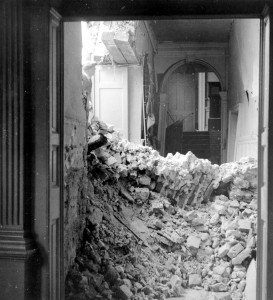Given that there’s so much in the news about flu outbreaks at the moment, I thought it would be interesting to look at some of the reactions to the influenza outbreak in 1919, from the Kingsley Wood scrapbook which covers the period November 1918 to October 1919. During this time, Sir Howard Kingsley Wood was involved in the setting up of the new Ministry of Health, as well as being part of the Local Government Board and M.P. for Woolwich.
The Spanish flu outbreak of 1918-1920 swept across the world with huge numbers of fatalities, particularly killing younger victims through an overreaction of the immune system. Those with weaker immune systems were therefore more able to survive the virus. The devastating effects of the Spanish flu were exacerbated by the First World War, through lifestyle and the unusual population movement of seriously infected individuals.
The Daily Sketch published a self-congratulatory account of a ‘conference on influenza’ on 1st March 1919, which it claimed to have inspired. In the course of the public debate, the government’s advice to ‘keep fit’ was criticised, since fit people also fell ill. The chairman, Sir Malcolm Morris, also described the prescription of ‘a permanganate of potash and salt as a nasal douche’ as ‘”a horrible solution”‘. Dr Murray Lesli advised:
Start the day with a good breakfast ; have a brisk walk before starting work. Mental strain, lack of food and sleep, owing to the war are predisposing causes of influenza.
Oral cleanliness and good ventilation of public transport and public spaces were advocated; Dr Kirkhope, the Medical Officer for Health in Tottenham, advised that all badly ventilated cinemas should be closed. However, Kirkhope also argued that the disease was not influenza but a ‘continuation of many diseases’, since, at this time, scientists not yet conclusively discovered the causes of the flu virus.
‘Dr Lowe argued that we eat too much boiled food’
More ‘striking’ opinions included the demand by Sir St. Clair Thomson that anyone who coughed or sneezed on public transport ‘without putting a hand or handkerchief to the mouth should be prosecuted for indecency’. The possibility of taking ‘disciplinary measures’ against infected people who handled food and did not take precautions against infecting others seems to have been popular.
‘Persons with a cough should wear masks, but not the general public.’
According to this article, there was a difference of opinion amongst the experts about the ‘question of alcohol’; perhaps it is a coincidence that the lower section of the page is taken up by an endorsement of supplying whisky to those suffering with influenza!
As part of the ‘war on disease’, the first Minister for Health for England was appointed on 10th June 1919. Dr. Christopher Addison (1869-1951) had entered politics because he believed that governments were more able to change the health of the poor, and of society in general, than individual doctors. The Daily Mail announced Dr. Addison’s appointment in June 1919 as the start of a ‘war on disease’, where prevention was paramount in a country in which:
‘consumption is as prevalent today as smallpox in the seventeenth century.’
One of the many improvements associated with social welfare and efforts to improve the nation’s health following the First World War were housing reforms. As the cutting from Answers from 2nd August 1919 put it, the intention was to ‘Scoot that Slum!’ The Daily News had reported in May of the same year that over three million people were living in cramped conditions of two to a room, describing a ‘great breeding place of disease.’
‘Bred in towns, reared in alleys, mewed up in stuffy rooms, no wonder people became irreligious, bat-eyed, materialistic, and Bolshevik.’
Kingsley Wood’s opinion of the place of slums as the cause of all the country’s ills were popular amongst many public-spirited gentleman of the time, who also wanted to build for the future. However, this proved difficult for the people who wanted to live in the newly developed ideal homes. Ways and Means from 6th September 1919 describes a leaked interview which Kingsley Wood gave to the Observer, in which he claimed that the government was ‘to-day settling where the Englishman of a hundred years hence is to live.’ While we may be grateful in 2019, the people of 1919 were more concerned with the ‘leaky lodgings and lack of lavatories’ which they had to put up with while the building work progressed increasingly slowly.
The Kingsley Wood scrapbooks are not yet catalogued but are in date order. They consist of cuttings largely from Sir Kingsley Wood’s political career and items of interest from his work as a lawyer. If you would like to look at these scrapbooks, email us at specialcollections@kent.ac.uk for an appointment.


